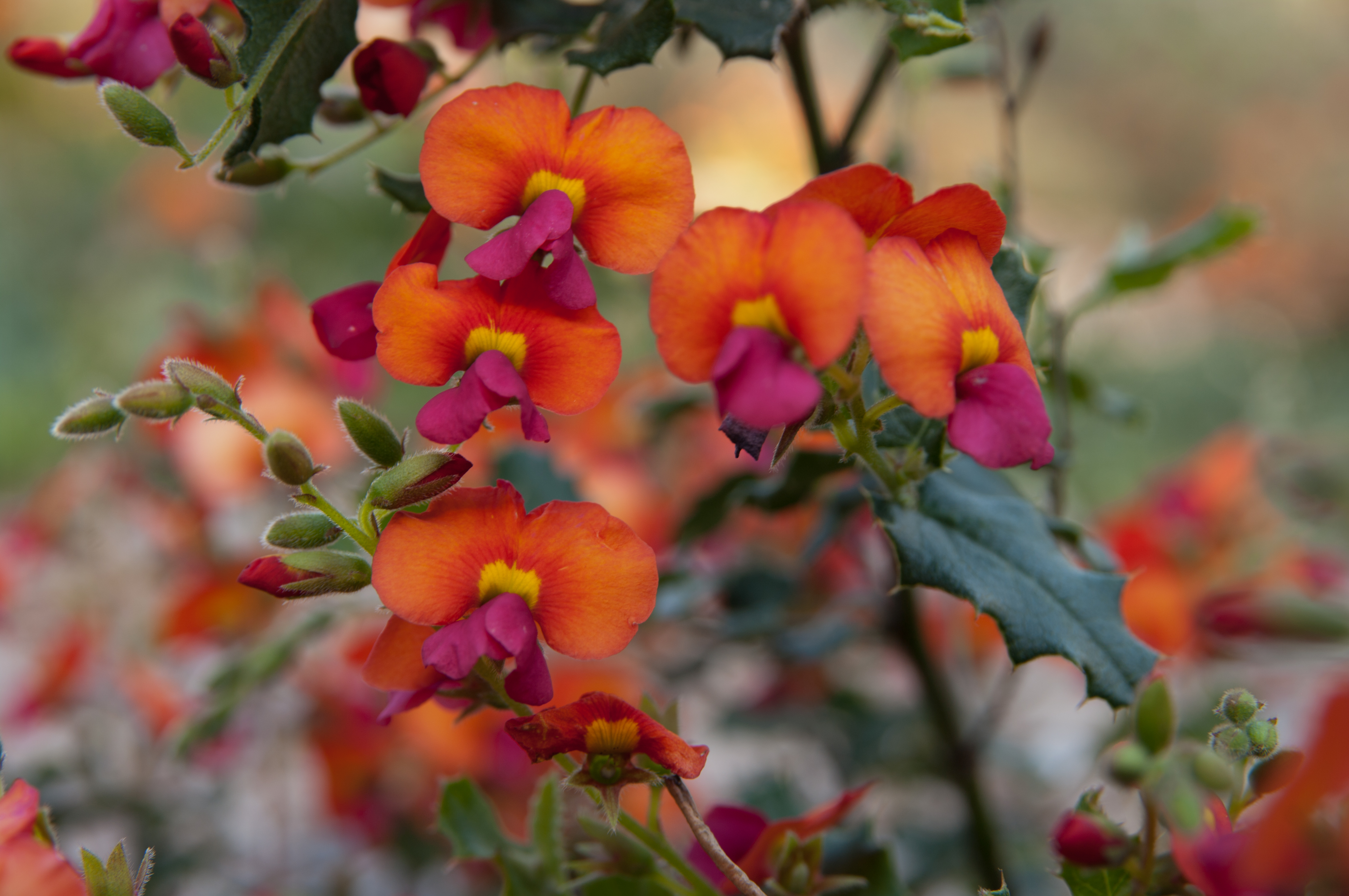|
Chorizema Rhynchotropis
''Chorizema rhynchotropis'' is a species of flowering plant in the family Fabaceae and is endemic to the southwest of Western Australia. It is a straggling, sprawling or erect shrub with linear, sharply-pointed leaves, and orange or red and pink and yellow pea flowers. Description ''Chorizema rhynchotropis'' is a straggling, sprawling or erect shrub with glabrous arching stems. Its leaves are linear, sharply-pointed, long wide and hairy. The flowers are orange, or red and pink and yellow, arranged in racemes on the ends of the branches, often forming long, leafy panicles, each flower on a pedicel long. The sepals are silky-hairy, about long, the lobes longer than the sepal tube. The standard petal is long, the wings long, and the keel long. Flowering occurs from August to November. Taxonomy and naming ''Chorizema rhynchotropis'' was first formally described in 1848 by Carl Meissner in Lehmann's ''Plantae Preissianae''. The specific epithet (''rhynchotropis'') means " ... [...More Info...] [...Related Items...] OR: [Wikipedia] [Google] [Baidu] |
Johann Georg Christian Lehmann
Johann Georg Christian Lehmann (25 February 1792 – 12 February 1860) was a German botanist. Born at Haselau, near Uetersen, Holstein, Lehmann studied medicine in Copenhagen and Göttingen, obtained a doctorate in medicine in 1813 and a doctorate in philosophy from the University of Jena in 1814. He spent the rest of his life as professor of physics and natural sciences, and head librarian, at the ''Gymnasium Academicum'' in Hamburg. A prolific monographist of apparently quarrelsome character, he was a member of 26 learned societies and the founder of the Hamburg Botanical Garden (, now the Alter Botanischer Garten Hamburg). Lehmann died at Hamburg in 1860. Some of Lehmann's later illustrations were executed by the German entomologist Johann Wilhelm Meigen Johann Wilhelm Meigen (3 May 1764 – 11 July 1845) was a German entomologist famous for his pioneering work on Diptera. Life Early years Meigen was born in Solingen, the fifth of eight children of Johann Cle ... [...More Info...] [...Related Items...] OR: [Wikipedia] [Google] [Baidu] |
Flora Of Western Australia
The flora of Western Australia comprises 10,551 published native vascular plant species and a further 1,131 unpublished species. They occur within 1,543 genera from 211 families; there are also 1,317 naturalised alien or invasive plant species more commonly known as weeds. There are an estimated 150,000 cryptogam species or nonvascular plants which include lichens, and fungi although only 1,786 species have been published, with 948 algae and 672 lichen the majority. History Indigenous Australians have a long history with the flora of Western Australia. They have for over 50,000 years obtained detailed information on most plants. The information includes its uses as sources for food, shelter, tools and medicine. As Indigenous Australians passed the knowledge along orally or by example, most of this information has been lost, along many of the names they gave the flora. It was not until Europeans started to explore Western Australia that systematic written details of the flora commen ... [...More Info...] [...Related Items...] OR: [Wikipedia] [Google] [Baidu] |
Fabales Of Australia
The Fabales are an order of flowering plants included in the rosid group of the eudicots in the Angiosperm Phylogeny Group II classification system. In the APG II circumscription, this order includes the families Fabaceae or legumes (including the subfamilies Caesalpinioideae, Mimosoideae, and Faboideae), Quillajaceae, Polygalaceae or milkworts (including the families Diclidantheraceae, Moutabeaceae, and Xanthophyllaceae), and Surianaceae. Under the Cronquist system and some other plant classification systems, the order Fabales contains only the family Fabaceae. In the classification system of Dahlgren the Fabales were in the superorder Fabiflorae (also called Fabanae) with three families corresponding to the subfamilies of Fabaceae in APG II. The other families treated in the Fabales by the APG II classification were placed in separate orders by Cronquist, the Polygalaceae within its own order, the Polygalales, and the Quillajaceae and Surianaceae within the Rosa ... [...More Info...] [...Related Items...] OR: [Wikipedia] [Google] [Baidu] |
Chorizema
''Chorizema'' is a genus of flowering plants in the family Fabaceae. They are small, evergreen shrubs and climbers native to scrub habitats in Australia, valued in cultivation for their pea-like flowers. Most species do not tolerate frost, and in temperate regions require the protection of glass. Species list The following species and subspecies are accepted by the Australian Plant Census as at June 2020: * ''Chorizema aciculare'' (DC.) C.A.Gardner ** ''Chorizema aciculare'' (DC.) C.A.Gardner subsp. ''aciculare'' ** ''Chorizema aciculare'' subsp. ''laxum'' J.M.Taylor & Crisp * ''Chorizema carinatum'' ( Meisn.) J.M.Taylor & Crisp * ''Chorizema circinale'' J.M.Taylor & Crisp * ''Chorizema cordatum'' Lindl. * ''Chorizema cytisoides'' Turcz. * '' Chorizema dicksonii'' Graham * '' Chorizema diversifolium'' A.DC. * '' Chorizema genistoides'' (Meisn.) C.A.Gardner * ''Chorizema glycinifolium'' (Sm.) Druce * ''Chorizema humile'' Turcz. * '' Chorizema ilicifolium'' Labill. * ''C ... [...More Info...] [...Related Items...] OR: [Wikipedia] [Google] [Baidu] |
Geraldton Sandplains
Geraldton ( Wajarri: ''Jambinu'', Wilunyu: ''Jambinbirri'') is a coastal city in the Mid West region of the Australian state of Western Australia, north of the state capital, Perth. At June 2018, Geraldton had an urban population of 37,648. Estimated resident population, 30 June 2018. Geraldton is the seat of government for the City of Greater Geraldton, which also incorporates the town of Mullewa, Walkaway and large rural areas previously forming the shires of Greenough and Mullewa. The Port of Geraldton is a major west coast seaport. Geraldton is an important service and logistics centre for regional mining, fishing, wheat, sheep and tourism industries. History Aboriginal Clear evidence has established Aboriginal people living on the west coast of Australia for at least 40,000 years, though at present it is unclear when the first Aboriginal people reached the area around Geraldton. The original local Aboriginal people of Geraldton are the Amangu people, with the N ... [...More Info...] [...Related Items...] OR: [Wikipedia] [Google] [Baidu] |
Avon Wheatbelt
The Avon Wheatbelt is a bioregion in Western Australia. It has an area of . It is considered part of the larger Southwest Australia savanna ecoregion. Geography The Avon Wheatbelt bioregion is mostly a gently undulating landscape with low relief. It lies on the Yilgarn Craton, an ancient block of crystalline rock, which was uplifted in the Tertiary and dissected by rivers. The craton is overlain by laterite deposits, which in places have decomposed into yellow sandplains, particularly on low hills. Steep-sided erosional gullies, known as breakaways, are common. Beecham, Brett (2001). "Avon Wheatbelt 2 (AW2 - Re-juvenated Drainage subregion)" in ''A Biodiversity Audit of Western Australia’s 53 Biogeographical Subregions in 2002''. Department of Conservation and Land Management, Government of Western Australia, November 2001. Accessed 15 May 2022/ref> In the south and west (the Katanning subregion), streams are mostly perennial, and feed rivers which drain westwards to empty i ... [...More Info...] [...Related Items...] OR: [Wikipedia] [Google] [Baidu] |
Binomial Nomenclature
In taxonomy, binomial nomenclature ("two-term naming system"), also called nomenclature ("two-name naming system") or binary nomenclature, is a formal system of naming species of living things by giving each a name composed of two parts, both of which use Latin grammatical forms, although they can be based on words from other languages. Such a name is called a binomial name (which may be shortened to just "binomial"), a binomen, name or a scientific name; more informally it is also historically called a Latin name. The first part of the name – the '' generic name'' – identifies the genus to which the species belongs, whereas the second part – the specific name or specific epithet – distinguishes the species within the genus. For example, modern humans belong to the genus '' Homo'' and within this genus to the species '' Homo sapiens''. '' Tyrannosaurus rex'' is likely the most widely known binomial. The ''formal'' introduction of this system of naming species is ... [...More Info...] [...Related Items...] OR: [Wikipedia] [Google] [Baidu] |
Plantae Preissianae
''Plantae preissianae sive enumeratio plantarum quas in australasia occidentali et meridionali-occidentali annis 1838-1841 collegit Ludovicus Preiss'', more commonly known as ''Plantae preissianae'', is a book written by Johann Georg Christian Lehmann and Ludwig Preiss. Written in Latin, it is composed of two volumes and was first published by Sumptibus Meissneri in Hamburg between 1844 and 1847. The two volumes were published in six separate parts. The books detail the plants collected by Ludwig Preiss, James Drummond, Thomas Livingstone Mitchell and Johann Lhotsky in Western Australia. The books are regarded as one of the earliest and most important contributions to the study of the flora of Western Australia. Priess amassed a collection of over 2,700 species of plants while in Western Australia from 1838 to 1842 when he returned to Germany. As a result of Priess' samples and notes Lehmann and his team of botanists, Stephan Endlicher, Christian Gottfried Daniel Nees von Ese ... [...More Info...] [...Related Items...] OR: [Wikipedia] [Google] [Baidu] |
Carl Meissner
Carl Daniel Friedrich Meissner (1 November 1800 – 2 May 1874) was a Swiss botanist. Biography Born in Bern, Switzerland on 1 November 1800, he was christened Meisner but later changed the spelling of his name to Meissner. For most of his 40-year career he was Professor of Botany at University of Basel. He made important contributions to the botanical literature, including the publication of the comprehensive work ''Plantarum Vascularum Genera'', and publications of monographs on the families Polygonaceae (especially the genus '' Polygonum''), Lauraceae, Proteaceae, Thymelaeaceae and Hernandiaceae. His contributions to the description of the Australian flora were prolific; he described hundreds of species of Australian Proteaceae, and many Australian species from other families, especially Fabaceae, Mimosaceae and Myrtaceae. His health deteriorated after 1866, and he was less active. He died in Basel , french: link=no, Bâlois(e), it, Basilese , neighboring_munic ... [...More Info...] [...Related Items...] OR: [Wikipedia] [Google] [Baidu] |
Fabaceae
The Fabaceae or Leguminosae,International Code of Nomenclature for algae, fungi, and plants. Article 18.5 states: "The following names, of long usage, are treated as validly published: ....Leguminosae (nom. alt.: Fabaceae; type: Faba Mill. Vicia L.; ... When the Papilionaceae are regarded as a family distinct from the remainder of the Leguminosae, the name Papilionaceae is conserved against Leguminosae." English pronunciations are as follows: , and . commonly known as the legume, pea, or bean family, are a large and agriculturally important family of [...More Info...] [...Related Items...] OR: [Wikipedia] [Google] [Baidu] |
Papilionaceous Flower
Papilionaceous flowers (from Latin: ''papilion'', a butterfly) are flowers with the characteristic irregular and butterfly-like corolla found in many, though not all, plants of the species-rich Faboideae subfamily of legumes. Tournefort suggested that the term ''Flores papilionacei'' originated with Valerius Cordus, who applied it to the flowers of the bean. Structure Corolla The flowers have a bilateral symmetry with the corolla consisting of five petals. A single, large, upper petal is known as the banner (also vexillum or standard petal). The semi-cylindrical base of the banner embraces and compresses two equal and smaller lateral wings (or alae). The wings in turn enclose a pair of small keel petals, that are situated somewhat lower than the wings, but are interior to them. They have concave sides and correspond with the shape of the wings. The two keel petals are fused at their bases or stuck together to form a boat-shaped structure that encloses the essential flower organ ... [...More Info...] [...Related Items...] OR: [Wikipedia] [Google] [Baidu] |







